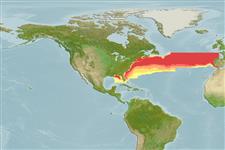Environment: milieu / climate zone / depth range / distribution range
Ecología
marino. Temperate; 48°N - 24°N, 89°W - 5°W
Western Atlantic: Nova Scotia in Canada to southern Florida in USA and eastern Gulf of Mexico (Ref. 7251). Eastern Atlantic: juveniles occasionally accompany floating objects across the Atlantic and have been recorded from Ireland, around the British Isles, off Portugal and the western Mediterranean.
Tamaño / Peso / Age
Maturity: Lm ? range ? - ? cm
Max length : 91.0 cm TL macho / no sexado; (Ref. 7251); common length : 30.0 cm SL macho / no sexado; (Ref. 4542); peso máximo publicado: 12.3 kg (Ref. 7251)
Lives in deep water over continental slopes. Adults in submarine canyons, young more widely found in surface layers and may occur at times close inshore docks. Young to 30 cm common in large groups during summer and autumn under floating boards, boxes and barrels. Does not associate with medusae. Adults probably schooling in depths but not on the bottom. Feed on small fishes and crustaceans; also sqiud and molluscs (Ref. 5951). Probably a spring spawner. (see Ref 4542).
Life cycle and mating behavior
Madurez | Reproducción | Puesta | Huevos | Fecundidad | Larva
Bauchot, M.-L., 1987. Poissons osseux. p. 891-1421. In W. Fischer, M.L. Bauchot and M. Schneider (eds.) Fiches FAO d'identification pour les besoins de la pêche. (rev. 1). Méditerranée et mer Noire. Zone de pêche 37. Vol. II. Commission des Communautés Européennes and FAO, Rome. (Ref. 3397)
IUCN Red List Status (Ref. 130435)
Threat to humans
Harmless
Human uses
Pesquerías: escaso valor comercial
Más información
Age/SizeCrecimientoLength-weightLength-lengthLength-frequenciesMorfometríaMorfologíaLarvaDinámica larvariaReclutamientoAbundanciaBRUVS
ReferenciasAcuiculturaPerfil de acuiculturaRazasGenéticaElectrophoresesheritabilidadEnfermedadesProcesamientoNutrientsMass conversion
Herramientas
Special reports
Download XML
Fuentes de Internet
Estimates based on models
Preferred temperature (Ref.
123201): 5.7 - 19.7, mean 11.6 °C (based on 85 cells).
Phylogenetic diversity index (Ref.
82804): PD
50 = 0.5156 [Uniqueness, from 0.5 = low to 2.0 = high].
Bayesian length-weight: a=0.00891 (0.00406 - 0.01955), b=3.10 (2.91 - 3.29), in cm total length, based on LWR estimates for this (Sub)family-body shape (Ref.
93245).
Nivel trófico (Ref.
69278): 3.9 ±0.55 se; based on food items.
Resiliencia (Ref.
120179): Bajo, población duplicada en un tiempo mínimo de 4.5-14 años (Preliminary K or Fecundity.).
Fishing Vulnerability (Ref.
59153): High vulnerability (56 of 100).
Nutrients (Ref.
124155): Calcium = 20.3 [12.4, 33.9] mg/100g; Iron = 0.387 [0.231, 0.644] mg/100g; Protein = 19.4 [16.9, 21.6] %; Omega3 = 0.753 [0.458, 1.202] g/100g; Selenium = 19.1 [10.4, 33.8] μg/100g; VitaminA = 16.6 [5.9, 48.8] μg/100g; Zinc = 0.416 [0.302, 0.583] mg/100g (wet weight);
